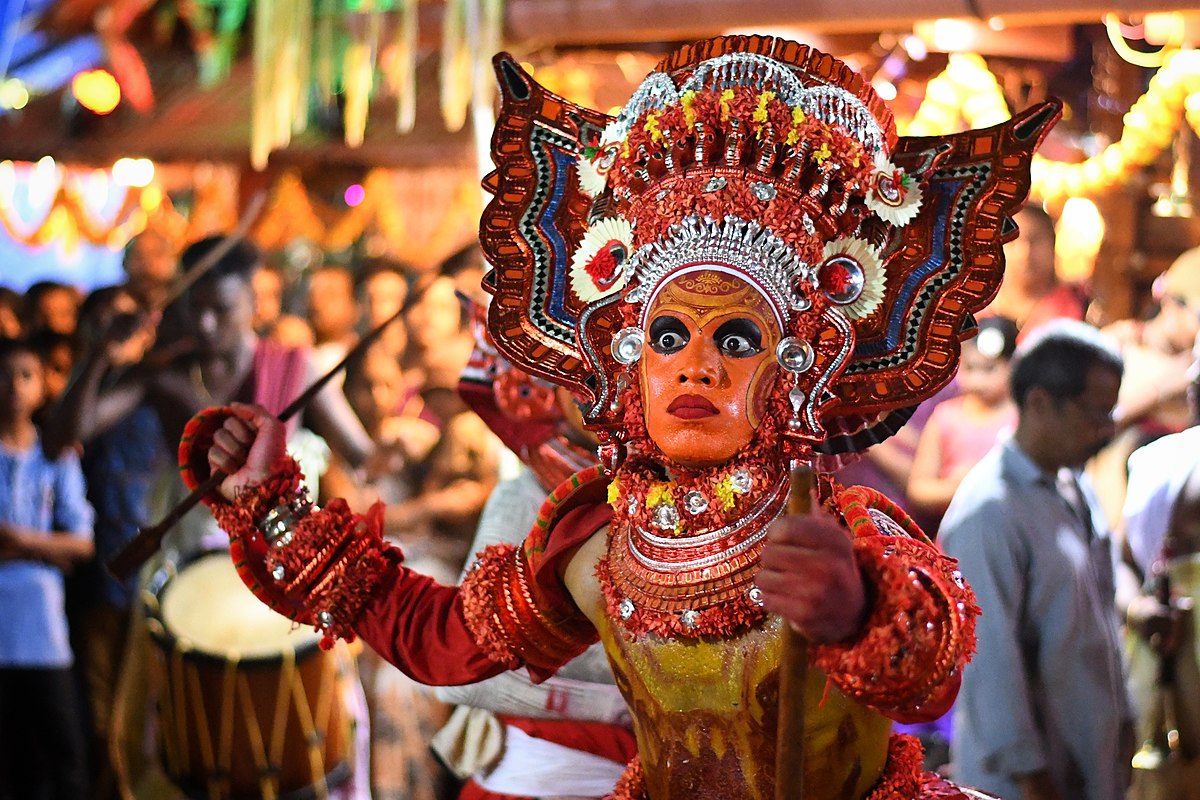Theyyam is the concept of a dancing deity. The dance form of Theyyam is also known as Theyyattam and Theyyakolam. The divine Worshiped theyyam kala is a mixture of magical, tactical, ritual, and fasting rituals. The theyyam is mostly of shiva bhootati, kali, chamundi, gandharva, yakshi, naga and the heros of the surrounding areas are all. They are the goddess. It is said that there are about five hundred theyyams. However around and hundred and twenty theyyams are common. Tree worship, mountain worship, mother worship, ghost worship, shiva- Vaishnava worship, and many more rituals are the combination of rituals. History says that theyyams are related to the social life of antiquity and the folks were reflected there. Most of the theyyams are related to the arts, rituals, and worship. Theyyakalam is the place of personal feelings to strengthen the unity of society. Folk art was also able to establish a sense of community. Many folk arts were transformed into means of repressed self-expression. Theyyam is a centuries-old art of north Malabar. this ritual is practiced in Kasargod and Kannur districts. Theyyam is a variant form of dance performed by the lower castes for the pleasure of God with non-clerical rituals. Theyyam is the verbal form of God. It is believed that god has given each community the right to tie certain sticks. Theyyam is a unique art form that combines mesmerizing beliefs with intricate and beautiful facial expressions, blood-colored costumes with ornaments and flowers, and orchestras such as chenda, chengila, elathalam, karumkuzhal, takil, and lasya tandava dances. Only through many years of training can one become a good Theyyam artist. Thottam pattu is a song that awakens the Theyyam by defeating (praying). Thottam songs (thottam pattu) are also a literary form that skillfully reflects the social life of the time. The young man who sings of defeat is called a loser. For some theyyams, the vellattam is tied yesterday. There are different legends behind the origin of each Theyyam, depending on the country and time, and attempts have been made since the time of Adi Shankaracharya to establish that the local customs and rituals of India are part of a Brahmin-dominated Hindu culture. There are lots of Attempts that have been made to establish that there is only one legend associated with Brahmanism behind the Theyyams. Payyannur and Perimchelloor (Taliparamba) temples in Kolathunadu, which were mostly populated by Brahmins, became popular due to the growth of Theyyam and other related arts. There is the belief that Parasuraman created Kaliyattam, Puravela, and Deviyattam (Theyyam) according to Kerala tradition. He gave permission to the Panan, Velan, and Vannan castes to perform Theyyam. Under the supervision of the Brahmins, these castes formed, developed, and improved Theyyam. After many social changes took place and the temples were taken over by the upper castes and the Theyyam was reserved only for the lower castes. To date, there has been no conflict between these castes in the name of Theyyam as there have never been any significant changes in the caste system. But there has been a great deal of Aryanization in the Theyyam and its history. Even in the name of Kaavus, "temple" modernization has taken place today. This was the legend of theyyakolam. In the middle of the month will end (around June 15) Theyyam at the Valapattanam Kalarivathukkal temple, the Theyyam of Bhagavathy, and the Kavil kalasam at Neeleswaram Mannanpuram. Kav, Kottam, Thanam (location), Ara, Palliyara, Mundya, and Kazhakam are the main places where the theyyams are performed. The earliest sites may have been tree roots. Trees like Pala, Chempakam, and Elanji are still used as sanctuaries. The origin of kavus can be traced back to tree worship. The theyyam art form is performed by the Vannan, Malayan, Anjuttan, Munnutan, Velan, Chinkathan, Mavilan, Koppalar, or Pulayan communities. Theyyams are differentiated from each other by facial expressions, it may be like costumes. Rice powder and turmeric powder are used for coloring the designs. The colors are mixed with fresh water and coconut oil. The presentation method and the method of practice are based on the local system. Decorations such as facial expressions, hair, costumes, and costumes help to diversify the look of the Theyyam. That can be classified as Thala chamayam, Kal chamayam, Ara chamayam and Kai chamayam. Except for the metal ones, all the decorations are made by the artists themselves. Theyyam dancers are always male and the skill and privilege are passed down from father to son, generation after generation. Different families will have the tradition of incarnating different deities. During the season, the dancer is a sanctified being and has to adhere to a vegetarian diet and celibate lifestyle and fulfill several other conditions. However, once the season is over, he will return to his normal, and often quite humble, job. The distinctions of the world that humans prize so much mean nothing to the gods; what they value is a pure heart and a willingness to serve and heed their advice. And it is the search for advice on everyday matters that draws most people to visit a Theyyam, in this capacity, the dancer acts as a practical and down-to-earth oracle.









Rahid C H
02 Oct, 2023 09.58AMgfgcjvjbknml